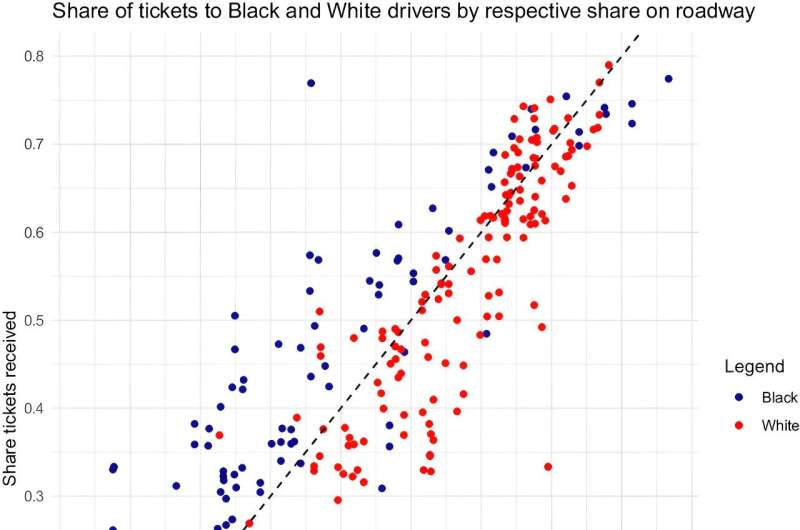This article has been reviewed according to Science X's editorial process and policies. Editors have highlighted the following attributes while ensuring the content's credibility:
fact-checked
peer-reviewed publication
trusted source
proofread
Study finds racial bias in traffic stops by Chicago police

Black drivers in Chicago are significantly more likely than white drivers to be stopped by police regardless of where the drivers live or are going, according to a new study led by a Cornell city planning expert that maps the racial composition of roads by using mobile phone GPS data. The study confirms a racial bias in traffic stops that the researchers say is replacing stop and frisk as a new tactic for discrimination.
In addition to police stops, the researchers investigated ticketing by speed cameras deployed across the city, finding Black drivers were ticketed more—but roughly in proportion to the racial makeup of drivers in those locations. On a street where data showed half of drivers were Black, the researchers found a 54% probability of Black drivers being issued a camera ticket.
In comparison, police-initiated traffic stops showed a "strong overrepresentation" of Black motorists relative to the proportion on the roads—and the reverse for white drivers. On a street with 50% Black drivers, they comprised about 70% of the police stops, on average. Where half of drivers were white, fewer than 20% of stops involved white drivers.
"This is the first time that we've had such a granular, block-by-block understanding of a bias in traffic enforcement, showing that police disproportionately stop Black drivers at a higher rate," said Wenfei Xu, assistant professor of city and regional planning in the College of Architecture, Art and Planning (AAP) and director of the Urban Data Research Lab.
Xu, a Chicago native, is the first author of the paper "The Racial Composition of Road Users, Traffic Citations, and Police Stops," published June 3 in the Proceedings of the National Academy of Sciences with co-authors including Houpu Li, a master's student in city and regional planning (AAP), and experts from Rutgers University; the University of Illinois, Chicago; and the University of Sydney in Australia.
While previous research has provided evidence of racial profiling in traffic stops, the demographics of the people stopped are often measured against the makeup of the adjacent neighborhood, rather than the demographics of drivers on the road. Xu's team introduced a new level of detail by analyzing traffic stops and citations based on who is actually driving, down to the level of city blocks and intersections.
"Looking simply at the surrounding area is not the best approach for understanding what is happening across a city, because people who drive are often going through a neighborhood and not to it," said David Levinson, professor of transportation in the University of Sydney's School of Civil Engineering and a co-author of the research.
"There are a number of theories proposed to establish and understand the sources of police racial bias in traffic enforcement, but it is hard to deny that it exists."
To conduct their analysis, the researchers obtained data from Replica, a mobility analytics platform, illustrating traffic patterns on a representative (pre-pandemic) day in 2020, encompassing 46 million trips in the Chicago metro area. Leveraging cellphones' repeated signaling of their location, Replica's anonymized models generate a "synthetic" population that reflects the racial composition of drivers throughout the day.
Through freedom of information requests, the research team then collected Chicago Police Department data for 2019 on nearly 650,000 traffic stops and more than 700,000 tickets issued by roughly 160 traffic cameras across the city. The scholars compared the demographics from those events to the roads' racial composition.
"Regardless of where you are in the city and the makeup of drivers on the road," said Xu, "Black drivers are always a higher proportion of those that are stopped."
The justification for the stops—whose number have increased steadily over the past decade—seems questionable, Xu said, since a small fraction result in arrests, and a smaller percentage uncover illegal gun possession. But traffic stops can escalate into dangerous encounters that place Black Americans at higher risk—the 2016 police killing of Philando Castile in Minnesota being one high-profile example.
In disproportionately impacting minority residents, Xu said the traffic stops appear to mirror stop-and-frisk policies criticized for systemic racial bias. Cities and their police departments, she said, should consider prohibiting stops for minor offenses such as a broken taillight or expired registration.
More information: Wenfei Xu et al, The racial composition of road users, traffic citations, and police stops, Proceedings of the National Academy of Sciences (2024). DOI: 10.1073/pnas.2402547121
Journal information: Proceedings of the National Academy of Sciences
Provided by Cornell University



















